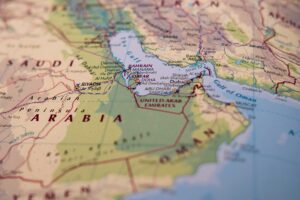It has been reported that failure to reach the objectives of the Paris Agreement may cause irreversible damages, making the Earth utterly inhospitable for human beings in the long run. At the same time, financial losses could escalate to trillions of dollars and the worst impacts of climate change might be irreparable at any cost[i].
The United Nations Environment Programme’s press release, in addition to a number of other scientific reports, show inadequate progress on climate action by the international community, highlighting that a credible pathway to meet climate targets is lacking[ii]. Latest emission gap reports revealed that the world is falling far short of the Paris Agreement goals and global GHG emissions have increased by 1.2 percent from 2021 to 2022[iii][iv]. It has also been reported in the proceedings of the COP28 conference that the progress made by the most vulnerable countries to the effects of climate change is too slow to meet emission reduction targets by the end of this decade[v]. In response to these shortcomings, signatories to the Paris Agreement make promises every year to get back on track to achieve the desired results until 2030, reducing emissions as needed.
A clear progress chart with quantitative emission reduction results by every member country may be made available for the public, who have been waiting that global warming can reasonably be counteracted to protect the planet from increasing natural disasters and extreme weather conditions.
The question arises: how to meet targets to stop the increasing temperatures and their related effects if progress has been insufficient?
It has been suggested that every member country to the Paris Agreement, or at least all developing members be checked if they are actively engaged in advancing technologically to progressively reduce emissions. While most developed countries are using the latest technologies to meet their emission targets, developing nations often lack the expertise and equipment to make similar strides. Despite being highly advanced, China, the USA and the EU are among the top emitters of the world and are unable to meet their emission reduction targets due to various policy issues[vi]. However, these countries possess a well-equipped technical infrastructure as well as the expertise to be on track and contribute well to mitigating global warming.
There is a set of NDCs (or Nationally Determined Contributions, in which countries communicate their actions in order to reduce greenhouse gas emissions) published by almost all members, but these NDCs often lack specific details of the operational procedures employed or the exact nature of the projects to be executed. It appears that member countries have been given a free hand to choose the projects they believe they can successfully carry out as per their available resources and technological know-how. For this reason too, decisionmakers at successive COP climate change conferences look towards the developing world with worry as the world edges closer to 2030. The entire sector and community of policymakers invested in it would benefit from establishing a list of projects with well-defined quantitative outcomes, which member countries could refer to and choose from.
According to Climate Pledges Explorer International Energy Agency, the average emission reduction made by member countries per year was 297.6 million tonnes from 2010 to 2022. The required emission reduction in average from 2022 is reported at 542.3 million tonnes per year to meet 2030 targets. This collective global target necessitates the use of all possible technologies available[vii].
As for the latter, there are some well-established technologies to be adopted by developing countries to increase their contributions for the attainment of the above target. The Paris Agreement Implementation and Compliance Committee (PAICC) and funding agencies involved in furthering the Agreement’s mission could do more to facilitate, monitor and enforce that member countries are using all established technologies and are on track to meet their allotted emission reduction targets. One way to make progress could be by providing established technologies or even share equipment with member countries so that they could follow the best available technical guidelines and execute their national climate change projects to the largest effect possible. Monitoring and enforcing mechanisms could also be improved—or in some cases created—by requiring signatories to the Agreement to display their progressive attempts on emission reduction and demonstrate the value of ongoing or completed projects with quantitative results. Repeatedly acknowledging falling short of targets at COP conferences and providing advice and recommendations to accelerate efforts is insufficient.
Beside established emission reduction targets, alternative means of facilitating progress should also be encouraged by practical means. For example, if 40 mature trees can absorb 1 ton of CO2 per year, 50% of the 2030 target (542.3 million tonnes) may be achieved by planting 56 million trees on average in each member country per year[viii]. The remaining 50% of the planet’s emission reduction would, of course, necessitate the use of established technologies, which include the conversion of carbon dioxide into products like low carbon fuel, building materials such as carbonates, bioenergy, waste management, bio based fuels, energy efficient devices and the continued promotion of promising renewable energy technologies.
The proceedings of the COP28 meetings raised concerns that progress was too slow to achieve the 2030 target in all areas of climate action. While member countries have made some promising commitments to accelerating their efforts, can observers reasonably believe that the next COP meeting, to take place this November in Baku, Azerbaijan, will showcase some satisfactory intermediate results?
Keeping in mind broader development-related issues in developing countries, enhanced or multiplied action should not be expected to be carried out at the same pace as in the world’s wealthiest countries. The lack of financial resources remains a serious barrier in front of developing countries, which need to be directly funded to acquire established and advanced technologies in a range of fields, including effluent treatment, waste management, incineration, direct air capture and other renewable energy technologies applied in not only energy production, but also transportation, manufacturing and industrial activities. It is highly challenging for the industrial sectors of developing countries to install high-performance equipment to cut off chemical oxygen demand (COD) or biological oxygen demand (BOD) of effluents to meet the desirable emission standards. Similarly, the incineration of garbage or recycling of waste are not pursued in environment friendly ways in these countries in all sectors, but are typically handled manually, which increases pollution at all stages of processing. Authorities may consider to offer subsidies for the installation of the state-of-the-art equipment, focusing on industrial centres at least, which may act as hubs to manage waste from surrounding areas, facilitating the reduction of aquatic pollutants as well as greenhouse gas emissions around key areas of pollution. A facilitated boost in the adoption of advanced technologies by developing nations can promote them to contribute better towards emission reduction goals, and bring the 2030 milestone closer within reach.
Rising temperatures are swiftly escalating risks posed to the environment by producing extreme weather events such as heavy rains, floods, hurricanes, and wildfires on a more regular basis. Heat waves and years-long droughts in different regions of the world have also been experienced as direct consequences of global warming, which is not showing any mercy to the slow progress on emission reduction and the challenges posed by managerial or technical circumstances at the level of the member countries of the Paris Agreement.
Regarding the transition from fossil fuels, expert recommendations need to be reassessed. Currently, their utility and importance cannot be questioned and forced transition may create a substantial gap in maintaining existing developed infrastructure and productivity at a global level. However, the same issue may be addressed by promoting innovative methods to capture flue gases from engines of vehicles and other fossil fuel-powered equipment. Renewable energy technologies like solar, wind and other energy devices have already gained popularity but need years still to become a mainstream source of energy. Improving the efficiency and cost effectiveness of wind and ocean energy plants may similarly take time, as was the case with solar energy.
At COP29, policymakers will have an opportunity to make tangible progress in all of the above discussed areas. Their success at the conference is key to bringing the world’s 2030 emission targets closer to attainment.
[i] Maizland, L. (2023). “Global Climate Agreements: Successes and Failures”, Council on Foreign Relations, 5 December 2023, retrieved from: https://www.cfr.org/backgrounder/paris-global-climate-change-agreements#:~:text=Scientists%20warn%20that%20if%20this,floods%2C%20and%20widespread%20species%20loss.
[ii] UN Environment Programme (2022). “Inadequate progress on climate action makes rapid transformation of societies only option – UNEP”, 27 October 2022, retrieved from: https://www.unep.org/news-and-stories/press-release/inadequate-progress-climate-action-makes-rapid-transformation.
[iii] UN Environment Programme (2022). “Emission Gap Report 2022”, 27 October 2022, retrieved from: https://www.unep.org/resources/emissions-gap-report-2022.
[iv] UN Environment Programme (2023). “Emission Gap Report 2023”, 20 November 2023, retrieved from: https://www.unep.org/resources/emissions-gap-report-2023.
[v] United Nations Climate Change (2023). “COP 28: What Was Achieved and What Happens Next?”, retrieved from: https://unfccc.int/cop28/5-key-takeaways.
[vi] Bown, C.P. and Clausing, K. (2023). “Together, China, the US, and the EU emit nearly half of the world’s greenhouse gases” 18 October 2023, retrieved from: https://www.piie.com/research/piie-charts/together-china-us-and-eu-emit-nearly-half-worlds-greenhouse-gases#:~:text=Together%2C%20China%2C%20the%20United%20States,of%20the%20world’s%20greenhouse%20gases.
[vii] IEA (2024). “Climate Pledges Explorer”, 24 September 2024, retrieved from: https://www.iea.org/data-and-statistics/data-tools/climate-pledges-explorer#overview.
[viii] Encon (2024). “Calculation of CO2 offsetting”, retrieved from: https://www.encon.eu/en/calculation-co2#:~:text=This%20means%20that%20one%20tonne,to%20500%20trees%20per%20hectare.

















